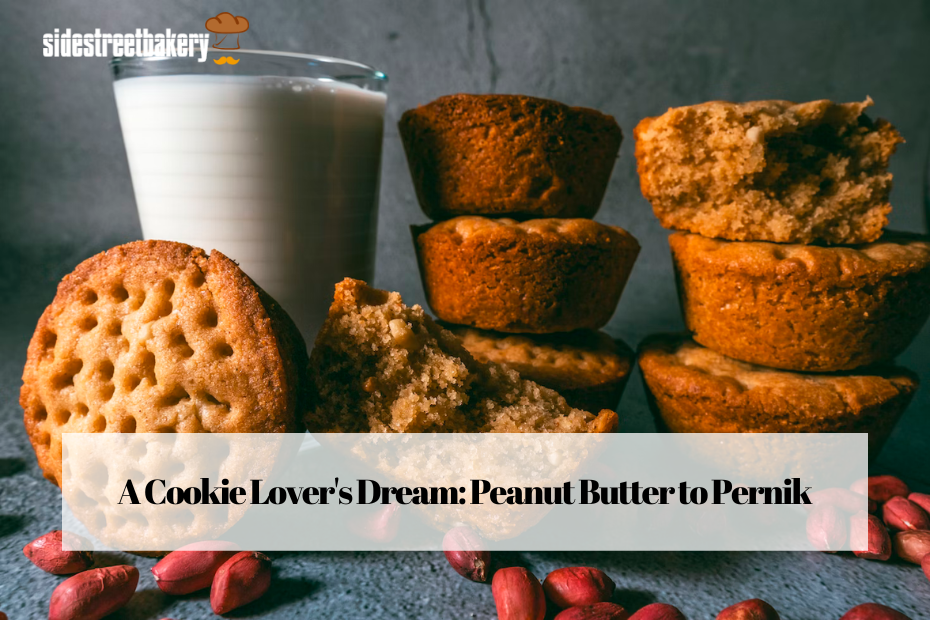Cookies, those irresistible, bite-sized confections, have been a source of comfort and delight for centuries. In this delightful exploration, we’ll embark on a mouthwatering journey through the diverse universe of cookies. From the classic Peanut Butter Cookie to the captivating Pernik, each cookie boasts a unique story, flavor profile, and cultural significance that has earned it a cherished place in the hearts of people worldwide.
Peanut Butter Cookie: A Timeless Favorite
The Peanut Butter Cookie is an enduring classic in the world of baked goods. Its distinctive feature is its waffle-like pattern, created by hand-rolling the dough and flattening it with fork tines. While this pattern is visually appealing, it also serves a functional purpose. It helps the cookies bake more evenly, ensuring that they have that perfect combination of crisp edges and a chewy center. But there’s more to it than just aesthetics. The pattern can also be seen as a subtle warning for those with peanut allergies, as it’s a visual cue that this cookie contains the beloved legume.

At its core, the dough of a Peanut Butter Cookie is a delectable blend of butter, peanut butter, eggs, milk, flour, sugar, and a pinch of salt. This harmonious medley of ingredients results in a rich, nutty flavor that pairs perfectly with a glass of milk. Such is the popularity of this cookie that it has its very own day of celebration – National Peanut Butter Cookie Day, a sweet occasion observed every year on June 12.
Canestrelli: Ancient Italian Butter Cookies
Stepping into the realm of Italian cookies, we encounter the delightful Canestrelli. These buttery confections have been a beloved treat since the Middle Ages and are often shared during festive occasions such as weddings and religious feasts. The name Canestrelli is wrapped in mystery, with its origins possibly stemming from the word “canestro,” which refers to a straw basket used for cooling the cookies after baking.

What distinguishes Canestrelli is its wide variety of recipes throughout Italy. However, the most renowned version is found in Liguria, where these cookies take the form of pale, flower-shaped shortbreads with a charming hole at their center. The contrast between their crisp exterior and the delicate interior is simply divine. Moving further afield, in Piedmont, you’ll find hard, waffle-shaped canestrelli that grace the tables of many households. Alternatively, in Biella, a version is crafted using two thin chocolate wafers joined by a sumptuous chocolate hazelnut cream. Canestrelli are a testament to the artistry and creativity in Italian baking.
Melomakarona: A Greek Christmas Tradition
In the heart of Greece, the arrival of the holiday season heralds the appearance of Melomakarona. These delightful semolina cookies boast a history that traces back to ancient Phoenicia. What gives these cookies their distinct taste are the traditional ingredients used: honey, orange zest, cinnamon, olive oil, and, at times, a dash of cognac. Immediately after being baked to golden perfection, these cookies take a delightful bath in honey syrup. The finishing touch? A sprinkling of ground walnuts adds a satisfying crunch to every bite.

Interestingly, there’s another Greek treat known as “finikia” that bears some resemblance to Melomakarona. However, finikia takes a slightly different path, occasionally being fried and served without walnuts. Today, both names are used interchangeably, and they have become synonymous with the joy and sweetness of Greek Christmas celebrations.
Pernik: Czech Artistic Cookies
The name “pernik” might conjure images of a soft ginger-spiced bundt cake, but in reality, it’s more closely associated with traditional Czech cookies. These cookies are generously spiced with a captivating blend of cinnamon, cloves, nutmeg, allspice, and ginger. What makes them truly extraordinary is their intricate decoration. The dough is meticulously cut into various shapes and then adorned with a beautiful array of toppings. These can include chocolate, yogurt, sliced almonds, candy, sugar glaze, or a simple dusting of powdered sugar.

The roots of Pernik cookies in the Czech Republic date back to 1335, where they were initially enjoyed as a dessert or used as a thickening agent in savory sauces. Over the centuries, these cookies have evolved into edible artworks, appreciated not just for their delectable flavors but also for their artistic value. Each cookie is a canvas, and the bakers are the artists.
Zimtsterne: Cinnamon Stars from Germany
The tantalizing aroma of cinnamon fills the air when Zimtsterne, or cinnamon stars, make an appearance. These star-shaped German cookies are created from a unique blend of whipped egg whites, sugar, and a generous amount of cinnamon. The traditional recipe calls for ground almonds, particularly the classic choice of almonds, occasionally combined with hazelnuts. The dough is carefully rolled and cut into star-shaped cookies that resemble celestial gems.
After the cookies emerge from the oven, a final touch of magic is added in the form of a white frosting. This frosting is made from a mixture of egg whites and sugar, imparting a delicate sweetness that complements the bold flavor of cinnamon. The result is a cookie that dazzles the senses with its warm, spicy notes and delicate texture.
Almendrados: A Taste of Spain
From the heart of Spain, we encounter Almendrados, traditional Spanish cookies that are simple yet profoundly delicious. Their creation involves a combination of blanched almonds, granulated sugar, eggs, and a twist of lemon zest. The process begins by whipping egg whites until they reach a stiff, glossy consistency. These whipped egg whites are then harmoniously combined with sugar, egg yolks, lemon zest, and finely ground almonds. For those who desire an extra layer of flavor, cinnamon can be added.
Shaped into mounds or pyramids, these cookies are baked until they achieve a beautiful golden hue. Almendrados trace their origins back to the 15th century, or possibly even earlier, making them a culinary treasure with a rich history. They continue to be a beloved treat during the festive Christmas season, offering a taste of Spain’s cultural heritage with each delightful bite.
Baci di Dama: Italian “Lady’s Kisses”
The Italian pastry shops of Tortona, Piedmont, in the latter half of the 19th century, gave birth to a charming delicacy known as Baci di Dama, which translates to “lady’s kisses.” These cookies are composed of two hazelnut butter cookies sandwiched together with a layer of chocolate-hazelnut spread, akin to a tender embrace. The name “Baci di Dama” finds its origins in the visual resemblance of the cookies, evoking the image of two mouths kissing. The historical context adds a touch of charm to these delightful cookies, as it was once considered impolite for ladies to part their lips while kissing.
Baci di Dama are often savored as holiday cookies, imparting a sense of elegance and tradition to special occasions. They have even been playfully dubbed the Italian counterpart of the popular Oreo cookies, showcasing their universal appeal.
Whoopie Pie: The Amish Delight
Despite its intriguing name, the Whoopie Pie is a delightful cookie sandwich. This oversized treat features two soft chocolate cake cookies enveloping a sweet and fluffy white filling. The origins of the Whoopie Pie are often attributed to the Pennsylvania Amish community, but its popularity has transcended boundaries and is especially cherished in New England, particularly in Maine.
The story goes that when Amish children discovered these sweet treats in their lunch bags, they couldn’t contain their excitement. They would joyfully exclaim “Whoopie!” at the sight of these delectable pies, thereby giving rise to the charming name.
Oatmeal Cookies: A Versatile American Classic
Oatmeal Cookies, versatile and beloved, have secured their place in the annals of American culinary history. These cookies typically feature rolled oats, sugar, eggs, butter, and an assortment of spices. Often, you’ll find raisins incorporated into the dough, adding a burst of fruity sweetness to every bite. The exact origin of oatmeal cookies is a matter of debate, with some speculating that they evolved from Scottish oat-based cakes. However, it is widely accepted that they originated in the United States.
Fannie Merritt Farmer, the author of the Boston Cooking-School Cook Book, is often credited with being the first to publish a recipe for oatmeal cookies, which dates back to 1896. These cookies embody comfort, warmth, and the alluring aroma of home-baked goods. They’ve become a timeless classic and are beloved by all generations.
Palmier: The Puff Pastry Delight
Palmier, known by an array of whimsical nicknames such as “pig’s ear,” “elephant ear,” “glasses,” and “palm leaves,” is a delightful cookie that hails from the enchanting world of puff pastry. This elegant creation is made by sprinkling puff pastry with sugar, rolling it, and then cutting it into delicate slices. The result is a cookie that appears as a crisp, golden whirlwind of delicate layers.
Palmier is a versatile treat that can be enjoyed with a steaming cup of coffee or a fragrant pot of tea. Its appeal lies in its simplicity, making it a wonderful canvas for various sweet and savory spices and fillings. The beauty of Palmier is in its delicate layers that shatter with each bite, leaving behind a delightful trail of sugary flakes.
Meringue Cookies: Light and Airy Delights
Among the world of cookies, Meringue Cookies stand out as the epitome of lightness and delicacy. They are made from a thick and stiff mixture of whipped egg whites and sugar, creating a soft, airy texture that almost seems to defy gravity. Small portions of the meringue batter are piped onto a lined cookie sheet and baked until they puff up and achieve a crispy perfection.
What sets Meringue Cookies apart is their adaptability. They can be infused with a range of flavor extracts, vibrant food colorings, nuts, or the tangy sweetness of dried fruits. Each bite is an ethereal experience, with the cookies melting on the palate and releasing a burst of flavor.
Conclusion
The world of cookies is a diverse and enchanting one, brimming with a variety of flavors, textures, and stories. From the comforting familiarity of the Peanut Butter Cookie to the artistic intricacies of Pernik, every cookie tells a tale and offers a delightful experience for the taste buds. These sweet treats have transcended time and culture, becoming symbols of joy and togetherness. So, the next time you savor a cookie, remember that you’re also indulging in a piece of history and tradition.
Read Also:- Iconic Cookies: A Journey Through Sweet Treats and Global Flavors





